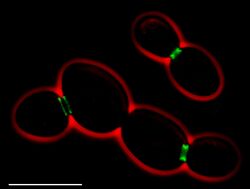Biology:Septum (cell biology)

• Green: septins (AgSEP7-GFP)
• Red: cell outline (phase contrast)
• Scale bar: 10 μm
A septum in cell biology is the new cell wall that forms between two daughter cells as a result of cell division.[1]
In yeast, septins form a ring structure, to which other proteins are recruited.[2] In particular, chitin synthase 2 is required, an enzyme that synthesises chitin thereby building up the primary septum. A secondary septum of β-glucans and mannoproteins is then assembled using the enzyme 1,3-Beta-glucan synthase, and the primary septum degraded during cell separation. After degradation of the primary septum, a chitinous bud scar remains on both the mother and daughter cell. [2][3]
Composition
In Schizosaccharomyces pombe, the primary septum is composed of linear β(1,3)-D-glucan, β(1,6) branches, and α(1,3)-D-glucan.[4] The secondary septum in Schizosaccharomyces pombe is composed of β(1,6)-D-glucan, β(1,6) branches, and α(1,3)-D-glucan.[4] The synthesis of linear β(1,3)-D-glucan for the primary septum is done by the enzyme β(1,3)-D-glucan synthase and regulated by a Rho GTPase.[4] Ags1/Mok1 enzyme is responsible for the synthesis of α(1,3)-D-glucan in the primary septum and secondary septum. [4]
References
- ↑ "Cell Division: Stages of Mitosis.". Nature Education 1 (1): 188. 2008. http://www.nature.com/scitable/topicpage/mitosis-and-cell-division-205#.
- ↑ 2.0 2.1 "The yeast cell wall and septum as paradigms of cell growth and morphogenesis". The Journal of Biological Chemistry 276 (23): 19679–82. June 2001. doi:10.1074/jbc.R000031200. PMID 11309404.
- ↑ "Cell wall assembly in Saccharomyces cerevisiae". Microbiology and Molecular Biology Reviews 70 (2): 317–43. June 2006. doi:10.1128/MMBR.00038-05. PMID 16760306.
- ↑ 4.0 4.1 4.2 4.3 "The Cell Biology of Fission Yeast Septation". Microbiology and Molecular Biology Reviews 80 (3): 779–91. September 2016. doi:10.1128/MMBR.00013-16. PMID 27466282.
 |

